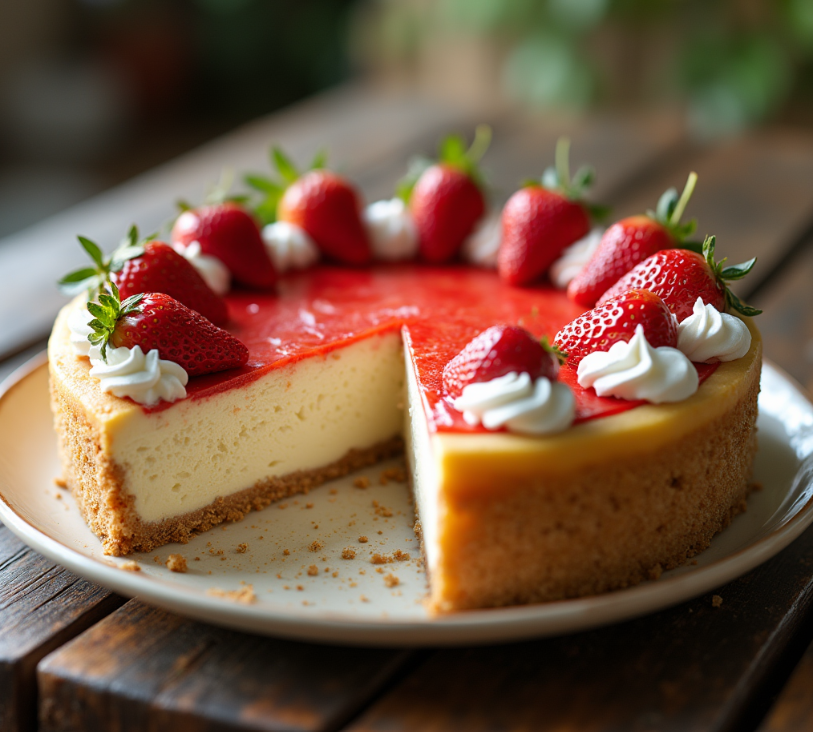Cheesecake, the luscious dessert adored worldwide, owes much of its magic to its base. But have you ever wondered what makes a cheesecake crust truly exceptional? Spoiler alert: it’s the biscuit! Whether you’re a fan of creamy New York-style cheesecake or experimenting with fruity toppings, choosing the right biscuit is a crucial step in perfecting your dessert. Stick with me as we explore what is the best biscuit to use for cheesecake base and how it can elevate your dessert to the next level.
Table of Contents
Understanding the Cheesecake Base: An Essential Foundation
Think of the cheesecake base as the unsung hero of this decadent dessert. While the silky filling gets all the glory, the base provides stability, texture, and a balanced flavor profile. It’s the yin to the cheesecake’s yang. Without it, you’re left with a dessert that feels incomplete—or worse, slides off the plate like a poorly built sandcastle.
But here’s the thing: not every biscuit can carry the weight of this responsibility. Some crumble too easily, some are too dense, and others simply don’t pair well with cheesecake. To truly master the art of cheesecake, you’ve got to understand the role of the base.
The Role of Biscuits in a Perfect Cheesecake Base
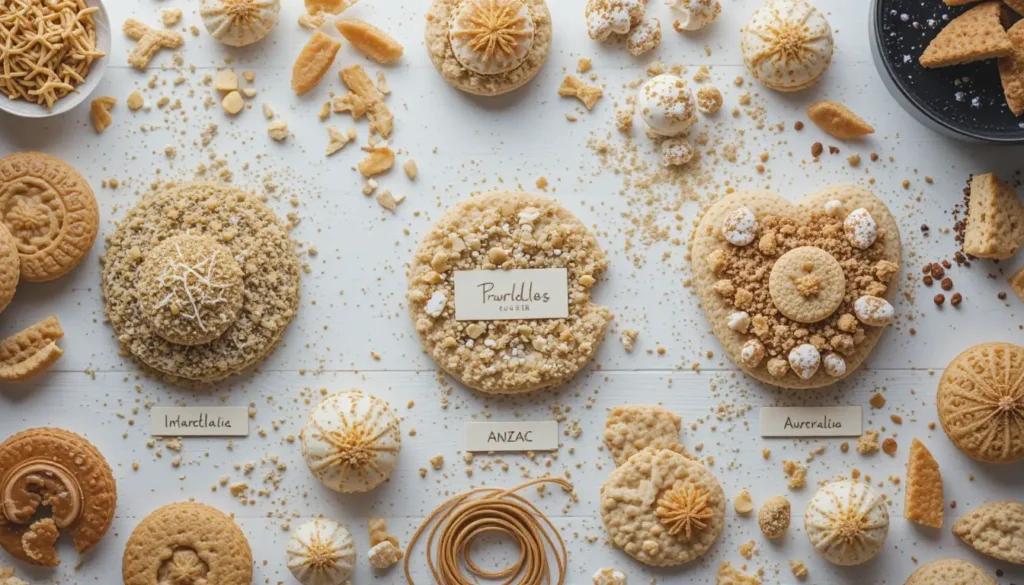
So, what exactly does the biscuit do in a cheesecake base? Let’s break it down:
- Texture: A cheesecake is a dance of contrasts—creamy filling paired with a firm, slightly crumbly crust. The biscuit provides that much-needed crunch, which turns a good cheesecake into a phenomenal one.
- Flavor Foundation: The biscuit sets the tone for the entire cheesecake. A neutral biscuit lets the filling shine, while a flavored one (like ginger or chocolate) adds a unique twist.
- Structure: With butter and a little pressure, those humble crumbs transform into a sturdy base that can hold even the heaviest of cheesecakes.
Key Characteristics of a Great Cheesecake Base Biscuit
What should you look for in a biscuit for your cheesecake? Not all biscuits are created equal, but a few key factors can guide you to the perfect pick.
Texture: Crunchy vs. Crumbly
The texture of your biscuit is a game-changer. Biscuits like digestive cookies or graham crackers strike the perfect balance—they’re easy to crush into fine crumbs, but they still provide that satisfying crunch when set.
On the other hand, overly soft biscuits can create a soggy base, while too-hard ones might make the crust feel heavy.
Flavor Profile: Sweet, Neutral, or Unique
Want your cheesecake to stand out? Consider the flavor of your biscuit. A sweet and simple option like graham crackers works well for most cheesecakes, but experimenting with bold flavors (like ginger or chocolate) can take your dessert to the next level.
Binding Ability: Holding the Base Together
If your crust doesn’t hold up when you slice your cheesecake, your dessert’s in trouble. The best biscuits absorb melted butter evenly, forming a solid, cohesive crust when pressed into the pan.
Popular Biscuits for Cheesecake Bases
Let’s dive into some tried-and-true biscuit options for the perfect cheesecake base. Whether you’re going for classic or creative, there’s a biscuit for every taste.
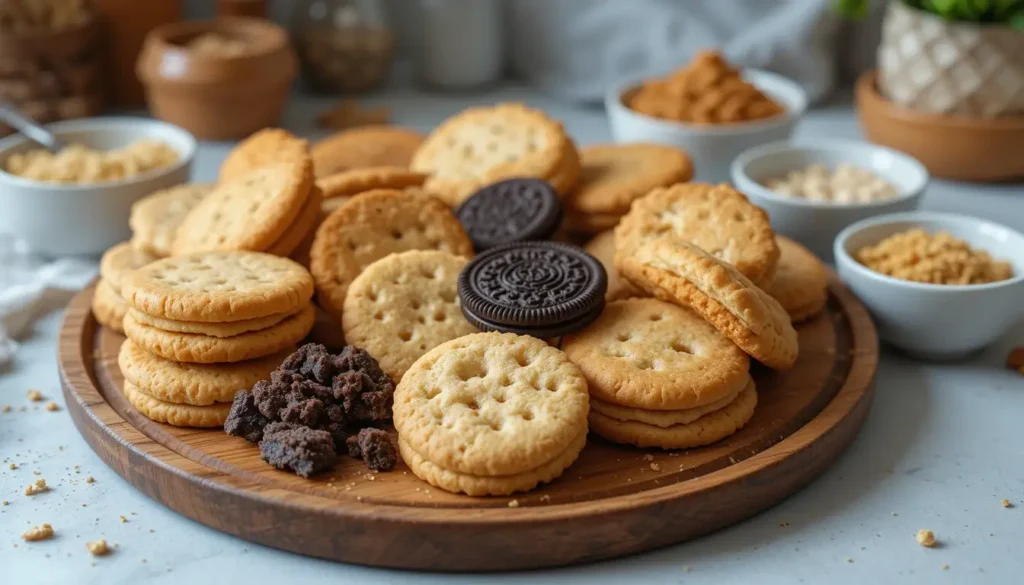
Digestive Biscuits: A Classic Choice
If cheesecakes had a soulmate, it’d be digestive biscuits. These lightly sweetened, whole meal cookies are beloved in the UK and beyond for their crumbly texture and mild flavor. They’re a go-to for traditional cheesecakes.
Graham Crackers: The American Favorite
Ask any cheesecake lover in the U.S., and they’ll likely swear by graham crackers. Slightly sweet, with a hint of honey or cinnamon, these crackers create a firm yet tender crust.
Shortbread: For a Buttery Indulgence
Want a base that’s rich and buttery? Shortbread is your answer. Its crumbly texture melts in your mouth, creating a luxurious foundation for cheesecakes.
Oreo Cookies: A Chocolate Twist
For chocolate lovers, Oreo cookies are a no-brainer. Their dark, cocoa-rich flavor adds depth to cheesecakes, especially when paired with chocolate or peanut butter fillings.
Gingersnaps: Adding a Spicy Kick
Feeling adventurous? Gingersnaps bring a warm, spicy flavor that pairs beautifully with citrus or pumpkin cheesecakes.
Customizing Your Cheesecake Base with Unique Biscuits
Why stick to the usual suspects when you can think outside the (biscuit) box? Let’s explore some creative ways to customize your cheesecake base.
Gluten-Free Options
If you or your guests are avoiding gluten, don’t worry—there are plenty of alternatives. Gluten-free graham crackers or almond-based biscuits work wonders without compromising on taste or texture.
Vegan Alternatives
For plant-based cheesecakes, opt for vegan cookies or biscuits. Brands like Lotus Biscoff offer vegan-friendly options that are both flavorful and versatile.
Experimenting with Regional Biscuits
Travel the world through your cheesecake base! Italian biscotti, French speculoos, or Australian ANZAC biscuits can add an international flair to your dessert.
Common Problems with Cheesecake Bases and How to Fix Them
Even the best bakers encounter hiccups with cheesecake bases. But don’t worry—we’ve got solutions to the most common issues. Let’s troubleshoot together!
Base Too Crumbly
Have you ever cut into a cheesecake only to have the crust fall apart? This is a sign that the biscuit-to-butter ratio isn’t quite right. Without enough butter, the crumbs won’t bind properly.
Fix:
- Increase the amount of melted butter in your mixture. A good rule of thumb is 1 part butter to 2 parts biscuit crumbs.
- Compact the base firmly using the back of a spoon or the flat bottom of a glass. Don’t overdo it, though—too much pressure can make it hard to cut.
Base Too Hard or Difficult to Cut
On the flip side, a base that feels like a brick wall can ruin the eating experience. This happens when the crust is overcompressed or baked for too long.
Fix:
- Be gentle when pressing the crumbs into the pan. Aim for a firm yet slightly springy texture.
- If baking the base, keep an eye on it—5-8 minutes in a preheated oven is usually enough. Overbaking can harden the crust.
Overly Sweet or Bland Flavors
The flavor of the crust should complement the filling, not overpower or underwhelm it. Using overly sweet biscuits can make the dessert cloying, while neutral ones might feel lackluster.
Fix:
- Balance sweetness by mixing different types of biscuits (e.g., digestive with gingersnaps).
- Add a pinch of salt to enhance the overall flavor profile.
Tips for Preparing the Perfect Cheesecake Base
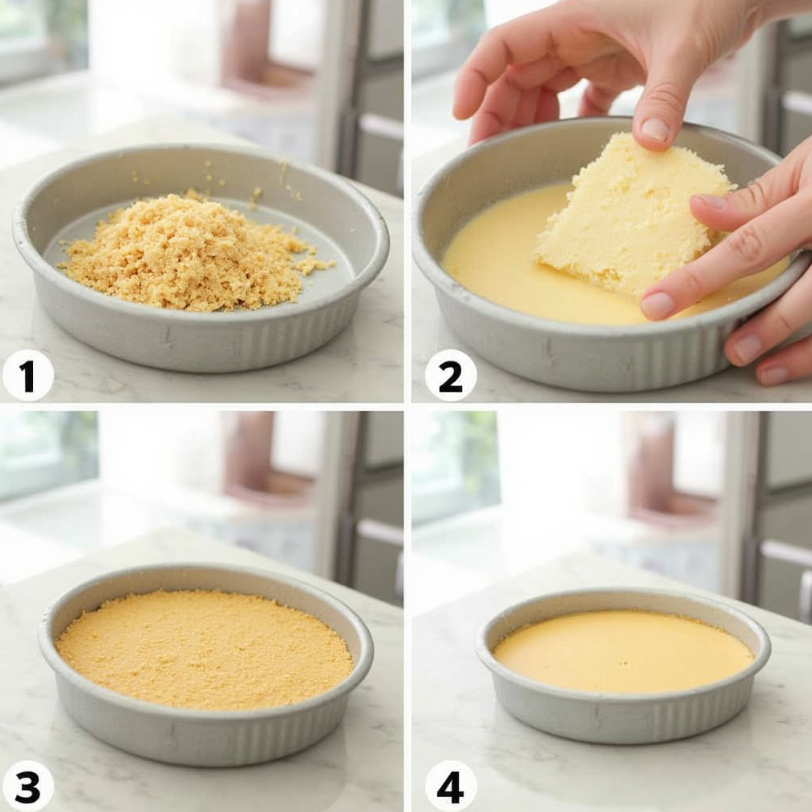
Creating a flawless cheesecake base isn’t rocket science, but a few tricks can make all the difference.
Achieving the Right Biscuit-to-Butter Ratio
Getting the proportions right is key to a sturdy yet tender base. Too much butter can make the crust greasy, while too little leaves it crumbly.
Pro Tip: Use this basic ratio:
- 2 cups of biscuit crumbs (around 200 grams)
- 1/2 cup of melted butter (115 grams)
This ratio works for most biscuit types, though you can adjust slightly based on the crumb consistency.
Compacting the Crust Evenly
Uniformity is essential for an even base that slices neatly. Unevenly packed crumbs can lead to weak spots.
How to Do It:
- Spread the crumbs evenly over the pan.
- Use a flat-bottomed object, like a measuring cup, to press the mixture firmly and evenly.
- Pay extra attention to the edges, ensuring the crust reaches the sides without thinning out.
Choosing the Right Pan and Tools
The tools you use can make or break your cheesecake. Springform pans are a baker’s best friend—they allow you to remove the cheesecake without damaging the base.
Tips:
- Line the bottom of the pan with parchment paper for easy removal.
- Grease the edges lightly to prevent sticking.
Comparing Store-Bought vs. Homemade Biscuit Options
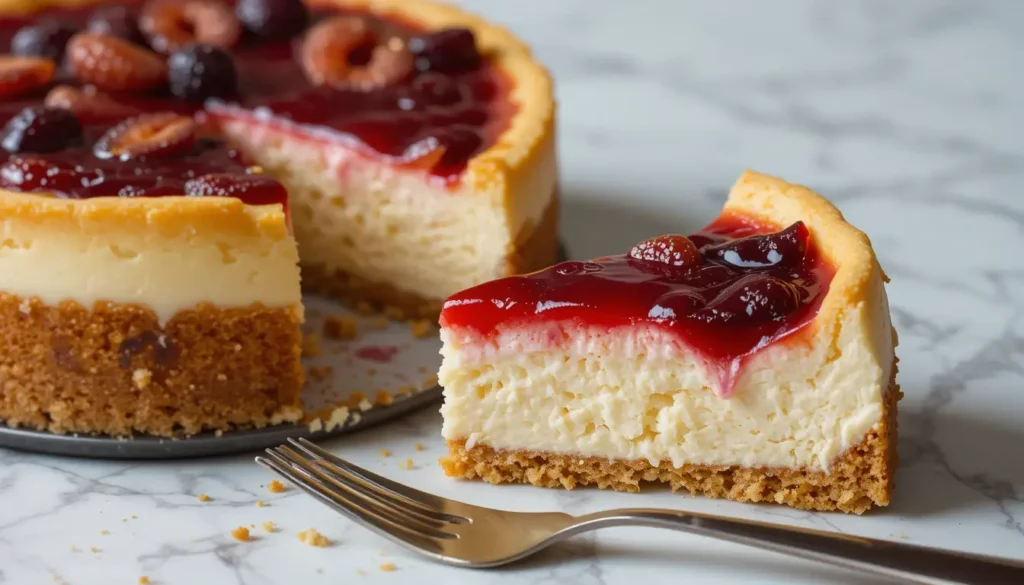
Let’s settle the age-old debate: Is it better to buy biscuits or make your own for the cheesecake base?
Store-Bought Biscuits
- Pros: Convenient, consistent, and widely available. Perfect for last-minute baking.
- Cons: Limited control over ingredients and flavor. Some options might be overly processed.
Homemade Biscuits
- Pros: Customizable flavors, fresh ingredients, and no added preservatives. Great for creating a unique cheesecake experience.
- Cons: Time-consuming and requires extra effort.
Ultimately, the choice depends on your priorities. If you’re short on time, store-bought biscuits like graham crackers or digestives are fantastic options. For special occasions, consider baking your own biscuits to make the cheesecake truly personal.
FAQs About Cheesecake Bases and Biscuits
Let’s address some burning questions about cheesecake bases:
What biscuits are best for a no-bake cheesecake?
Digestive biscuits, graham crackers, and shortbread are top choices for no-bake cheesecakes. They hold their shape without baking and pair well with chilled fillings.
Can I use cookies with cream fillings for a cheesecake base?
Absolutely! Oreos or similar cookies can be crushed, cream and all, for a decadent crust. Just reduce the butter slightly, as the cream filling adds moisture.
Why does my crust stick to the pan?
A sticky crust is often caused by skipping parchment paper or under-greasing the pan. Always prepare your pan properly to avoid this issue.
Can I make a cheesecake base without butter?
Yes, you can substitute butter with alternatives like coconut oil or margarine. Keep in mind that the flavor and texture may vary slightly.
How do I make a thicker cheesecake base?
Simply increase the amount of biscuit crumbs and butter. For an extra-thick base, press the mixture higher up the sides of the pan.
Can I add spices or nuts to the crust?
Absolutely! Adding spices like cinnamon or ground nuts like almonds can elevate the flavor profile of your crust.
Customizing Your Cheesecake Base with Unique Biscuits
Why stick to the basics when there’s a world of biscuits out there waiting to transform your cheesecake base? Let’s explore creative ways to give your dessert a personal touch.
Gluten-Free Options
Gluten-free cheesecakes are no longer a challenge with so many alternatives available. Opt for gluten-free graham crackers, almond flour biscuits, or even naturally gluten-free cookies like macarons. These substitutes ensure everyone at the table can enjoy your cheesecake without compromise, all while exploring what is the best biscuit to use for cheesecake base.
Vegan Alternatives
If you’re making a plant-based cheesecake, the biscuit base deserves equal consideration. Vegan-friendly biscuits like Lotus Biscoff or other dairy-free cookies provide an excellent starting point. Combine them with plant-based butter or coconut oil for a crust that’s as rich and satisfying as the traditional version.
Experimenting with Regional Biscuits
Regional biscuits can bring a unique twist to your cheesecake.
- Italian Amaretti: Perfect for almond-flavored cheesecakes.
- French Speculoos: Adds a caramelized, spicy note.
- Australian ANZAC Biscuits: Ideal for a chewy, oat-based crust.
Think of these as your passport to a global cheesecake experience! 🌍
Tips for Preparing the Perfect Cheesecake Base
We’ve touched on the essentials of crafting a great base, but let’s refine those techniques for professional results.
Balancing the Biscuit-to-Butter Ratio
The biscuit-to-butter ratio is the foundation of a crust that’s neither too dry nor overly greasy. Always start with the classic 2:1 ratio (2 parts biscuit crumbs to 1 part butter) and adjust slightly depending on the moisture content of your chosen biscuit.
Layering the Base
For added texture, consider layering your crust. Mix in crushed nuts, sprinkle a thin layer of sugar, or drizzle a bit of melted chocolate before adding the filling. These extra layers can add a delightful crunch and unexpected flavor.
Cooling and Setting
Once the crust is pressed into the pan, allow it to cool completely if baked or chill it for at least 30 minutes if unbaked. This ensures the base is firm and ready to support your creamy filling without cracking or crumbling.
Use a sharp knife dipped in warm water to slice through the crust cleanly. Wipe the blade between cuts to keep each slice neat.
Conclusion: Finding the Best Biscuit for Your Cheesecake
So, what is the best biscuit to use for a cheesecake base? The answer depends on your preferences, the flavor of your filling, and the occasion. Classic choices like digestive biscuits or graham crackers are always reliable, but don’t be afraid to get creative with options like Oreos, gingersnaps, or regional favorites.
At the heart of every cheesecake lies a crust that enhances the dessert experience. By choosing the right biscuit, mastering your technique, and experimenting with unique flavors, you can turn a good cheesecake into an unforgettable one.
Learn how to avoid mistakes by understanding why your cheesecake base goes soggy and applying practical tips.

